SAMOS Greek Island Off Ionia Ancient Silver GREEK Tetradrachm Coin NGC i85682
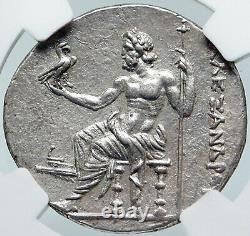
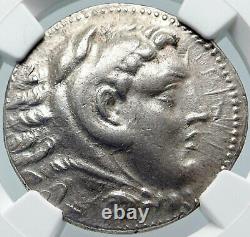
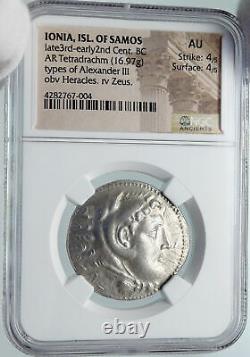
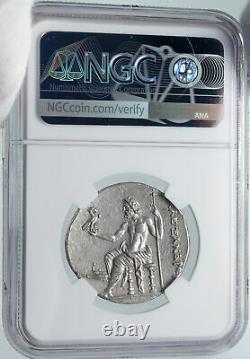
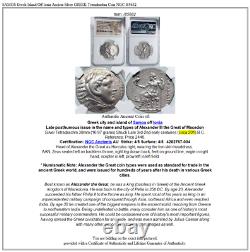

Item: i85682 Authentic Ancient Coin of. Greek city and island of Samos.
Late posthumous issue in the name and types of Alexander III the Great of Macedon Silver Tetradrachm 30mm (16.97 grams) Struck Late 3rd-2nd early centuries. AU Strike: 4/5 Surface: 4/5 4282767-004 Head of Alexander the Great as Hercules right, wearing the lion-skin headdress. AAN, Zeus seated left on backless throne, right leg drawn back, feet on ground line, eagle in right hand, scepter in left; prow left in left field. Numismatic Note: Alexander the Great coin types were used as standard for trade in the ancient Greek world, and were issued for hundreds of years after his death in various Greek cities.
Best known as Alexander the Great , he was a king (basileus in Greek) of the Ancient Greek kingdom of Macedonia. He was born in the city of Pella in 356 BC. By age 20, Alexander succeeded his father Philip II to the throne as king. He spent most of his years as king in an unprecedented military campaign of conquest through Asia, northeast Africa and even reached India.By age 30 he created one of the biggest empires in the ancient world, reaching from Greece to northwestern India. Being undefeated in battle, many consider him as one of history's most successful military commanders. He could be considered one of history's most important figures, having spread the Greek civilization far and wide, and was even admired by Julius Caesar along with many other important historical personages as well.
Alexander III of Macedon (20/21 July 356 BC - 10/11 June 323 BC), commonly known as Alexander the Great , was a king (basileus) of the Ancient Greek kingdom of Macedon and a member of the Argead dynasty. Born in Pella in 356 BC, Alexander succeeded his father, Philip II, to the throne at the age of twenty. He spent most of his ruling years on an unprecedented military campaign through Asia and northeast Africa, and by the age of thirty he had created one of the largest empires of the ancient world, stretching from Greece to northwestern India. He was undefeated in battle and is widely considered one of history's most successful military commanders. During his youth, Alexander was tutored by the philosopher Aristotle until the age of 16. After Philip's assassination in 336 BC, Alexander succeeded his father to the throne and inherited a strong kingdom and an experienced army. Alexander was awarded the generalship of Greece and used this authority to launch his father's Panhellenic project to lead the Greeks in the conquest of Persia. In 334 BC, he invaded the Achaemenid Empire, and began a series of campaigns that lasted ten years. Following the conquest of Asia Minor, Alexander broke the power of Persia in a series of decisive battles, most notably the battles of Issus and Gaugamela. He subsequently overthrew the Persian King Darius III and conquered the Achaemenid Empire in its entirety. At that point, his empire stretched from the Adriatic Sea to the Indus River. Seeking to reach the "ends of the world and the Great Outer Sea", he invaded India in 326 BC, but eventually turned back at the demand of his homesick troops. Alexander died in Babylon in 323 BC, the city he planned to establish as his capital, without executing a series of planned campaigns that would have begun with an invasion of Arabia. In the years following his death, a series of civil wars tore his empire apart, resulting in several states ruled by the Diadochi, Alexander's surviving generals and heirs. Alexander's legacy includes the cultural diffusion his conquests engendered, such as Greco-Buddhism. He founded some twenty cities that bore his name, most notably Alexandria in Egypt. Alexander's settlement of Greek colonists and the resulting spread of Greek culture in the east resulted in a new Hellenistic civilization, aspects of which were still evident in the traditions of the Byzantine Empire in the mid-15th century and the presence of Greek speakers in central and far eastern Anatolia until the 1920s. Alexander became legendary as a classical hero in the mold of Achilles, and he features prominently in the history and mythic traditions of both Greek and non-Greek cultures. He became the measure against which military leaders compared themselves, and military academies throughout the world still teach his tactics. He is often ranked among the most influential people in human history, along with his teacher Aristotle.Samos is a Greek island in the eastern Aegean Sea, south of Chios, north of Patmos and the Dodecanese, and off the coast of Asia Minor, from which it is separated by the 1.6-kilometre (1.0 mi)-wide Mycale Strait. It is also a separate regional unit of the North Aegean region, and the only municipality of the regional unit. In ancient times Samos was an especially rich and powerful city-state, particularly known for its vineyards and wine production. It is home to Pythagoreion and the Heraion of Samos, a UNESCO World Heritage Site that includes the Eupalinian aqueduct, a marvel of ancient engineering.
Samos is the birthplace of the Greek philosopher and mathematician Pythagoras, after whom the Pythagorean theorem is named, the philosopher Epicurus, and the astronomer Aristarchus of Samos, the first known individual to propose that the Earth revolves around the sun. Samian wine was well known in antiquity, and is still produced on the island. The island was governed by the semi-autonomous Principality of Samos under Ottoman suzerainty from 1835 until it joined Greece in 1912. In classical antiquity the island was a center of Ionian culture and luxury, renowned for its Samian wines and its red pottery (called Samian ware by the Romans).
Its most famous building was the Ionic order archaic Temple of goddess Hera-the Heraion. Concerning the earliest history of Samos, literary tradition is singularly defective. At the time of the great migrations it received an Ionian population which traced its origin to Epidaurus in Argolis: Samos became one of the twelve members of the Ionian League.
By the 7th century BC it had become one of the leading commercial centers of Greece. This early prosperity of the Samians seems largely due to the island's position near trade-routes, which facilitated the importation of textiles from inner Asia Minor, but the Samians also developed an extensive oversea commerce.They helped to open up trade with the population that lived around the Black Sea as well as with Egypt, Cyrene (Libya), Corinth, and Chalcis. This caused them to become bitter rivals with Miletus. Samos was able to become so prominent despite the growing power of the Persian empire because of the alliance they had with the Egyptians and their powerful fleet. The Samians are also credited with having been the first Greeks to reach the Straits of Gibraltar. The feud between Miletus and Samos broke out into open strife during the Lelantine War (7th century BC), with which we may connect a Samian innovation in Greek naval warfare, the use of the trireme.
The result of this conflict was to confirm the supremacy of the Milesians in eastern waters for the time being; but in the 6th century the insular position of Samos preserved it from those aggressions at the hands of Asiatic kings to which Miletus was henceforth exposed. About 535 BC, when the existing oligarchy was overturned by the tyrant Polycrates, Samos reached the height of its prosperity.
Its navy not only protected it from invasion, but ruled supreme in Aegean waters. The city was beautified with public works, and its school, of sculptors, metal-workers and engineers achieved high repute.Main article: Tunnel of Eupalinos. In the 6th century BC Samos was ruled by the famous tyrant Polycrates. During his reign, two working groups under the lead of the engineer Eupalinos dug a tunnel through Mount Kastro to build an aqueduct to supply the ancient capital of Samos with fresh water, as this was of the utmost defensive importance (since being underground, it was not easily detected by an enemy who could otherwise cut off the supply).
Eupalinos' tunnel is particularly notable because it is the second earliest tunnel in history to be dug from both ends in a methodical manner. With a length of over 1 km (0.6 mi), Eupalinos' subterranean aqueduct is today regarded as one of the masterpieces of ancient engineering. The aqueduct is now part of the UNESCO World Heritage Site, the Pythagoreion.Persian Wars and Persian rule. After Polycrates' death Samos suffered a severe blow when the Persian Achaemenid Empire conquered and partly depopulated the island. It had regained much of its power when in 499 BC it joined the general revolt of the Ionian city-states against Persia; but owing to its long-standing jealousy of Miletus it rendered indifferent service, and at the decisive battle of Lade (494 BC) part of its contingent of sixty ships was guilty of outright treachery. In 479 BC the Samians led the revolt against Persia, during the Battle of Mycale, which was part of the offensive by the Delian League (led by Cimon). During the Peloponnesian War (431-404 BC), Samos took the side of Athens against Sparta, providing their port to the Athenian fleet.
In the Delian League they held a position of special privilege and remained actively loyal to Athens until 440 when a dispute with Miletus, which the Athenians had decided against them, induced them to secede. With a fleet of sixty ships they held their own for some time against a large Athenian fleet led by Pericles himself, but after a protracted siege were forced to capitulate. It was punished, but Thucydides tells us not as harshly as other states which rebelled against Athens. Most in the past had been forced to pay tribute but Samos was only told to repay the damages that the rebellion cost the Athenians: 1,300 talents, to pay back in installments of 50 talents per annum. At the end of the Peloponnesian War, Samos appears as one of the most loyal dependencies of Athens, serving as a base for the naval war against the Peloponnesians and as a temporary home of the Athenian democracy during the revolution of the Four Hundred at Athens (411 BC), and in the last stage of the war was rewarded with the Athenian franchise.This friendly attitude towards Athens was the result of a series of political revolutions which ended in the establishment of a democracy. After the downfall of Athens, Samos was besieged by Lysander and again placed under an oligarchy. In 394 the withdrawal of the Spartan navy induced the island to declare its independence and reestablish a democracy, but by the peace of Antalcidas (387) it fell again under Persian dominion. It was recovered by the Athenians in 366 after a siege of eleven months, and received a strong body of military settlers, the cleruchs which proved vital in the Social War (357-355 BC).
After the Lamian War (322), when Athens was deprived of Samos, the vicissitudes of the island can no longer be followed. Panorama of Pythagoreion, the place of birth of Pythagoras. Perhaps the most famous persons ever connected with classical Samos were the philosopher and mathematician Pythagoras and the fabulist Aesop. In 1955 the town of Tigani was renamed Pythagoreio in honor of the philosopher. Other notable personalities include the philosopher Epicurus, who was of Samian birth and the astronomer Aristarchus of Samos, whom history credits with the first recorded heliocentric model of the solar system.
The historian Herodotus, known by his Histories resided in Samos for a while. There was a school of sculptors and architects that included Rhoecus, the architect of the Temple of Hera (Olympia), and the great sculptor and inventor Theodorus, who is said to have invented with Rhoecus the art of casting statues in bronze. The vases of Samos were among the most characteristic products of Ionian pottery in the 6th century. Main articles: Hellenistic Greece and Roman Greece. For some time (about 275-270 BC) Samos served as a base for the Egyptian fleet of the Ptolemies, at other periods it recognized the overlordship of Seleucid Syria.
In 189 BC, it was transferred by the Romans to their vassal, the Attalid dynasty's Hellenistic kingdom of Pergamon, in Asia Minor. Enrolled from 133 in the Roman province of Asia Minor, Samos sided with Aristonicus (132) and Mithridates (88) against its overlord, and consequently forfeited its autonomy, which it only temporarily recovered between the reigns of Augustus and Vespasian. Nevertheless, Samos remained comparatively flourishing, and was able to contest with Smyrna and Ephesus the title "first city of lonia"; it was chiefly noted as a health resort and for the manufacture of pottery. Since Emperor Diocletian's Tetrarchy it became part of the Provincia Insularum, in the diocese of Asiana in the eastern empire's pretorian prefecture of Oriens. World-renowned expert numismatist, enthusiast, author and dealer in authentic ancient Greek, ancient Roman, ancient Byzantine, world coins & more. Ilya Zlobin is an independent individual who has a passion for coin collecting, research and understanding the importance of the historical context and significance all coins and objects represent. Send me a message about this and I can update your invoice should you want this method. Getting your order to you, quickly and securely is a top priority and is taken seriously here. Great care is taken in packaging and mailing every item securely and quickly. What is a certificate of authenticity and what guarantees do you give that the item is authentic? You will be very happy with what you get with the COA; a professional presentation of the coin, with all of the relevant information and a picture of the coin you saw in the listing.Additionally, the coin is inside it's own protective coin flip (holder), with a 2x2 inch description of the coin matching the individual number on the COA. Whether your goal is to collect or give the item as a gift, coins presented like this could be more prized and valued higher than items that were not given such care and attention to.
When should I leave feedback? Please don't leave any negative feedbacks, as it happens sometimes that people rush to leave feedback before letting sufficient time for their order to arrive. The matter of fact is that any issues can be resolved, as reputation is most important to me. My goal is to provide superior products and quality of service.How and where do I learn more about collecting ancient coins? Visit the Guide on How to Use My Store.
For on an overview about using my store, with additional information and links to all other parts of my store which may include educational information on topics you are looking for. The item "SAMOS Greek Island Off Ionia Ancient Silver GREEK Tetradrachm Coin NGC i85682" is in sale since Tuesday, August 18, 2020. This item is in the category "Coins & Paper Money\Coins\ Ancient\Greek (450 BC-100 AD)".
The seller is "highrating_lowprice" and is located in Rego Park, New York. This item can be shipped worldwide.- Certification Number: 4282767-004
- Certification: NGC
- Grade: AU
- Composition: Silver
- Denomination: Tetradrachm
- Era: Ancient
- Year: Year_in_description

